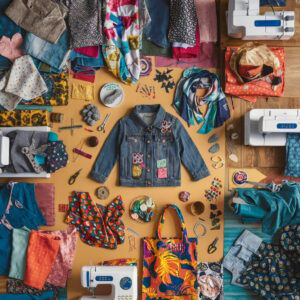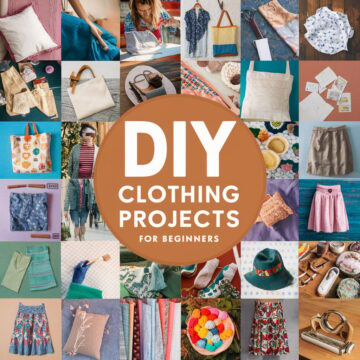Getting Started with DIY Clothing Projects
Gathering Essential Tools and Materials
Before diving into your DIY clothing projects, assembling the right tools and materials is crucial. Start with a reliable sewing machine, sharp scissors, and an assortment of needles and pins. Don’t forget to stock up on thread in various colors to match your fabric choices. A measuring tape, fabric chalk, and an iron are also indispensable for achieving professional-looking results.
Choosing Your First Project
As a beginner, it’s wise to start small. Consider simple projects like customizing a t-shirt, creating a tote bag, or hemming pants. These projects will help you build confidence and develop basic skills without overwhelming you. Look for patterns labeled “easy” or “beginner-friendly” to ensure a positive first experience.
Understanding Fabric Basics
Familiarize with different fabric types and their characteristics. Cotton is often recommended for beginners due to its ease of handling. Learn about fabric grain and how it affects your project’s outcome. Practice cutting fabric properly and understand the importance of prewashing to prevent shrinkage after your project is complete.
Mastering Basic Sewing Techniques
Begin by learning fundamental sewing techniques such as straight stitching, backstitching, and pivoting corners. Practice these skills on scrap fabric before starting your actual project. Understanding how to read and follow a pattern is also essential for success in your DIY clothing endeavors.
Easy DIY Clothing Projects for Beginners
Getting started with DIY clothing projects can be both exciting and intimidating. However, with a few simple ideas, you can transform your wardrobe without breaking the bank or needing advanced sewing skills. Here are some easy projects to kickstart your DIY fashion journey:
No-Sew T-Shirt Makeovers
Transform plain tees into stylish pieces without threading a needle. Try these quick techniques:
- Fringe the bottom edge for a bohemian look
- Create side ties for a fitted silhouette
- Cut a wide scoop neck to update the neckline
Simple Embellishments
Add flair to existing garments with easy embellishments:
- Iron-on patches for instant personality
- Fabric paint designs for custom artwork
- Studded accents for an edgy touch
Basic Sewing Projects
If you’re ready to try sewing, start with these beginner-friendly ideas:
- Elastic-waist skirts from fabric squares
- Drawstring bags for stylish storage
Infinity scarves for year-round accessorizing
Remember, DIY clothing is about expressing your creativity. Don’t be afraid to experiment with colors, patterns, and techniques. With practice, you’ll gain confidence and tackle more complex projects. Start small, have fun, and watch your unique style bloom through these easy DIY clothing projects.
Tips and Tricks for DIY Clothing Projects
Start with Simple Projects
Begin your DIY clothing journey with straightforward projects. T-shirt modifications, like cropping or adding fringe, are perfect for beginners. These projects require minimal sewing skills and allow you to experiment with design without the pressure of complex techniques.
Invest in Quality Tools
While it’s tempting to cut corners, investing in good-quality tools will make your DIY experience much smoother. A sharp pair of fabric scissors, a reliable sewing machine, and proper measuring tape are essential. Don’t forget about ironing supplies – they’re crucial for achieving a polished look.
Practice Proper Fabric Care
Understanding fabric care is vital for successful DIY projects. Always pre-wash your fabric to prevent shrinkage after you’ve sewn your garment. Read care labels carefully and treat different materials accordingly. This step ensures your hard work lasts longer and looks better.
Embrace Upcycling
Get creative with upcycling old clothes. Transform oversized shirts into stylish dresses or turn worn-out jeans into trendy shorts. This approach not saves money but also reduces textile waste. Plus, it’s a great way to practice your skills on garments you’re not afraid to experiment with.
Don’t Skip the Planning Stage
Before cutting into your fabric, take time to plan. Sketch your design, make a paper pattern, and consider how the garment will fit and move. This preparation helps avoid costly mistakes and ensures your final product matches your vision.
Common Mistakes to Avoid with DIY Clothing Projects
Rushing the Process
One of the biggest pitfalls in DIY clothing projects is trying to finish too quickly. Remember, crafting your garments takes time and patience. Rushing can lead to sloppy stitching, misaligned patterns, or improperly fitted pieces. Take your time to measure twice and cut once, ensuring each step is done with care and precision.
Neglecting Fabric Care Instructions
Different fabrics require different handling. Ignoring care instructions can result in shrinkage, color bleeding, or fabric damage. Always pre-wash your fabric before cutting and sewing, and follow the recommended washing and ironing guidelines for each material type. This simple step can make a huge difference in the longevity and appearance of your finished project.
Overlooking Proper Tools and Equipment
While it’s tempting to dive in with just scissors and a needle, having the right tools can significantly improve your results. Invest in quality scissors, pins, a seam ripper, and an iron. If you’re using a sewing machine, make sure it’s properly threaded and maintained. Using dull scissors or skipping pressing seams can lead to frustration and subpar results.
Ignoring Pattern Instructions
Patterns are there for a reason. Skipping steps or altering the order can lead to confusion and mistakes. Read through the entire pattern before starting, and follow each step carefully. Pay special attention to grain lines, notches, and seam allowances. These details ensure your pieces fit together correctly and your finished garment looks professional.
FAQs
What tools do I need to start DIY clothing projects?
To begin your DIY clothing journey, you’ll need some basic tools. These include fabric scissors, a sewing machine (or needle and thread for hand-sewing), measuring tape, fabric chalk or markers, and an iron. As you progress, you might want to invest in a seam ripper, pinking shears, and a rotary cutter for more advanced projects.
How can I pick the ideal fabric for my undertaking?
Selecting the appropriate fabric is crucial for your DIY clothing project’s success. Consider the garment’s purpose, the season it’s intended for, and your skill level. Beginners should start with stable, easy-to-work fabrics like cotton or linen. As you gain experience, you can experiment with stretchy or delicate materials like jersey knits or silk.
What are some easy DIY clothing projects for beginners?
There are several simple projects perfect for novice crafters:
- T-shirt modifications (crop tops, tie-dye, or adding embellishments)
- Tote bags or simple drawstring backpacks
- Elastic-waist skirts
- No-sew fleece scarves or blankets
- Upcycling old jeans into shorts or a denim skirt
These projects allow you to practice basic techniques while creating functional, personalized items.
Conclusion
In conclusion, DIY clothing projects offer an exciting way to express your creativity and refresh your wardrobe on a budget. By starting with simple techniques like hemming and embellishing, you can gradually build your skills to tackle more complex projects. Remember to choose fabrics and patterns that suit your style and skill level. With practice and patience, you’ll soon be creating unique, personalized garments that reflect your taste. Whether upcycling old clothes or crafting entirely new pieces, the satisfaction of wearing something you’ve made yourself is unmatched. So grab your sewing kit, unleash your imagination, and embark on your DIY clothing journey today. Your one-of-a-kind fashion awaits!

[…] you look ahead to the future of clothing, exciting innovations are on the horizon. From sustainable fabrics to smart textiles, the garments […]